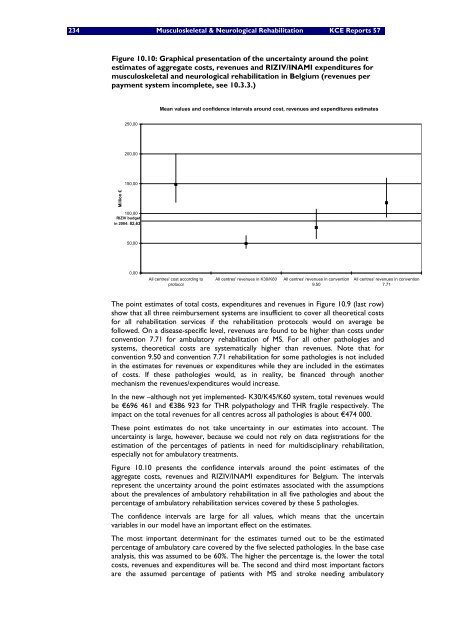The report is available in English with a French summary - KCE
The report is available in English with a French summary - KCE
The report is available in English with a French summary - KCE
Create successful ePaper yourself
Turn your PDF publications into a flip-book with our unique Google optimized e-Paper software.
234 Musculoskeletal & Neurological Rehabilitation <strong>KCE</strong> Reports 57<br />
Figure 10.10: Graphical presentation of the uncerta<strong>in</strong>ty around the po<strong>in</strong>t<br />
estimates of aggregate costs, revenues and RIZIV/INAMI expenditures for<br />
musculoskeletal and neurological rehabilitation <strong>in</strong> Belgium (revenues per<br />
payment system <strong>in</strong>complete, see 10.3.3.)<br />
Million €<br />
250,00<br />
200,00<br />
150,00<br />
100,00<br />
RIZIV budget<br />
<strong>in</strong> 2004: 82,63<br />
50,00<br />
0,00<br />
Mean values and confidence <strong>in</strong>tervals around cost, revenues and expenditures estimates<br />
All centres' cost accord<strong>in</strong>g to<br />
protocol<br />
All centres' revenues <strong>in</strong> K30/K60 All centres' revenues <strong>in</strong> convention<br />
9.50<br />
All centres' revenues <strong>in</strong> convention<br />
7.71<br />
<strong>The</strong> po<strong>in</strong>t estimates of total costs, expenditures and revenues <strong>in</strong> Figure 10.9 (last row)<br />
show that all three reimbursement systems are <strong>in</strong>sufficient to cover all theoretical costs<br />
for all rehabilitation services if the rehabilitation protocols would on average be<br />
followed. On a d<strong>is</strong>ease-specific level, revenues are found to be higher than costs under<br />
convention 7.71 for ambulatory rehabilitation of MS. For all other pathologies and<br />
systems, theoretical costs are systematically higher than revenues. Note that for<br />
convention 9.50 and convention 7.71 rehabilitation for some pathologies <strong>is</strong> not <strong>in</strong>cluded<br />
<strong>in</strong> the estimates for revenues or expenditures while they are <strong>in</strong>cluded <strong>in</strong> the estimates<br />
of costs. If these pathologies would, as <strong>in</strong> reality, be f<strong>in</strong>anced through another<br />
mechan<strong>is</strong>m the revenues/expenditures would <strong>in</strong>crease.<br />
In the new –although not yet implemented- K30/K45/K60 system, total revenues would<br />
be €696 461 and €386 923 for THR polypathology and THR fragile respectively. <strong>The</strong><br />
impact on the total revenues for all centres across all pathologies <strong>is</strong> about €474 000.<br />
<strong>The</strong>se po<strong>in</strong>t estimates do not take uncerta<strong>in</strong>ty <strong>in</strong> our estimates <strong>in</strong>to account. <strong>The</strong><br />
uncerta<strong>in</strong>ty <strong>is</strong> large, however, because we could not rely on data reg<strong>is</strong>trations for the<br />
estimation of the percentages of patients <strong>in</strong> need for multid<strong>is</strong>cipl<strong>in</strong>ary rehabilitation,<br />
especially not for ambulatory treatments.<br />
Figure 10.10 presents the confidence <strong>in</strong>tervals around the po<strong>in</strong>t estimates of the<br />
aggregate costs, revenues and RIZIV/INAMI expenditures for Belgium. <strong>The</strong> <strong>in</strong>tervals<br />
represent the uncerta<strong>in</strong>ty around the po<strong>in</strong>t estimates associated <strong>with</strong> the assumptions<br />
about the prevalences of ambulatory rehabilitation <strong>in</strong> all five pathologies and about the<br />
percentage of ambulatory rehabilitation services covered by these 5 pathologies.<br />
<strong>The</strong> confidence <strong>in</strong>tervals are large for all values, which means that the uncerta<strong>in</strong><br />
variables <strong>in</strong> our model have an important effect on the estimates.<br />
<strong>The</strong> most important determ<strong>in</strong>ant for the estimates turned out to be the estimated<br />
percentage of ambulatory care covered by the five selected pathologies. In the base case<br />
analys<strong>is</strong>, th<strong>is</strong> was assumed to be 60%. <strong>The</strong> higher the percentage <strong>is</strong>, the lower the total<br />
costs, revenues and expenditures will be. <strong>The</strong> second and third most important factors<br />
are the assumed percentage of patients <strong>with</strong> MS and stroke need<strong>in</strong>g ambulatory

















